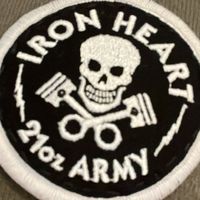Random questions to which you seek an answer
-
My Dude!

-

-
@popvulture
I like the stain treatment method you use with the dawn… Just the regular blue stuff? You used that method on indigo dyed stuff without any spots or weirdness after washing? That’s awesome! I will keep that in the back of my mind for stain emergencies (God forbid). I have learned from seeing other people mistakes on this forum and from finding clothes for sale with weird spots in the indigo, that spot treating and trying to rub on stains is a very dangerous endeavor. -
Yeah, just regular Dawn or you could also use Palmolive — the key is that it's a petroleum-based dish soap. Something more natural like Mrs. Meyers won't work. I forget where I learned it (Martha Stewart?) but first tried it when I got some oil on a t-shirt I loved while I was cooking something splattery in the kitchen. It'll take it right out, even if the stain's been on there for a while and has been washed. Basically that detergent's got petroleum to break down grease, and ta-da — it does the same for oil-based stains on clothes. Really one of the best tricks I've ever learned. Laundry witchcraft.
I've worried that it'd affect the indigo, but as of yet I've tried it on the OD 21oz and the wabash with no problems. That said, I guess there's always a risk, but I think there's a lot less than if you were to like try to scrub out a stain with a toothbrush or something.
@Filthy is also a Dawn acolyte

-
Thanks man
 I’ll keep it in the emergency kit!!
I’ll keep it in the emergency kit!! -
You bet!

-
Yeah I always add a tablespoon of real Dawn any time I soak or hand wash my jeans. The use it to clean tar off of baby seals after oil spills, so it's completely safe to use my n your jeans

-
I have never had vertical fades other than train tracks, and for whatever reason, while I love train tracks, it would bother me to have vertical fade lines other than those. My OCD shows up in strange places.
I'm sure there are many other factors to consider, but my method is gentle, cold cycles with gentle detergent and no softener, inside-out, pre-soaked, no spin, hang to drip dry, then turn back outside-out when fully dry. And I only wash when I notice a smell or there's been a stain that spot-cleaning couldn't eliminate, which is very infrequent–but I don't think the frequency's really a factor in the vertical creasing/fades, though a higher frequency might help mask them.
I fold the outseams forward to store pulling the crotch back to align the outseams to one another, and then in half from there.
The only bad result I've ever had in the past decade or so with raw denim evo was when I didn't let me IH-634SII dry enough before turning them back outside-out and got some marbling.
-
A little crease sure as hell isn’t going to stop me from rocking these SBG 821’s… crease or not these are beautiful! And I’m going to wear them like I mean it!! Who knows if I’ll ever find another pair…

-
Nor would it me, though I do question the pairing with the mocs

that one is practically a train track… or maybe a monorail?
It would take a lot of damage to make me surrender those pants.
-
 nice…
nice… -
Yep bought them as work pants and just couldn’t do it. They have creases, marbling, and are at least an inch too short. Still couldn’t bring myself to wear them to work… maybe in a couple years

-
I’m really surprised how much I like them! SBG is so awesome!!
-
I have been a bit slow to notice this, but what's the thinking behind the side seams on IH shirts? I can only reference shirts I have, but some (298, 279) have the same seam on both sides (back panel goes under front) but most have asymmetric seams (back under front one side and front under back on the other). Is there some technical reason for making them this way, or is it just that H likes it that way?
-
It's probably something technical- based on my shirts, it looks like workshirts have side seams going the same way and westerns have them going opposite ways. Westerns have a gusset at the bottom, which must cause some change in construction technique.
-
Thanks @Chris. I spotted some evo in your answer before I could reply, so I guess it's a bit of a mystery. I have mostly work shirts and most have asymmetrical seams, so based on our combined experience it might not be a work/western split. The fabric weight/thickness explanation would make sense as (although I have no experience of sewing machines) it's generally the lighter/less bulky fabrics that have symmetrical seams. The gusset explanation is also plausible - of my IH shirts there is perfect gusset/asymetrical side seam correlation.
I have quite possibly spent too long inspecting the seams of my shirts :).
-
I have quite possibly spent too long inspecting the seams of my shirts :).
Yeah, same, which was part of the reason for the editing

Unfortunately, I did all that late at night and I don't think either of my answers were right…



